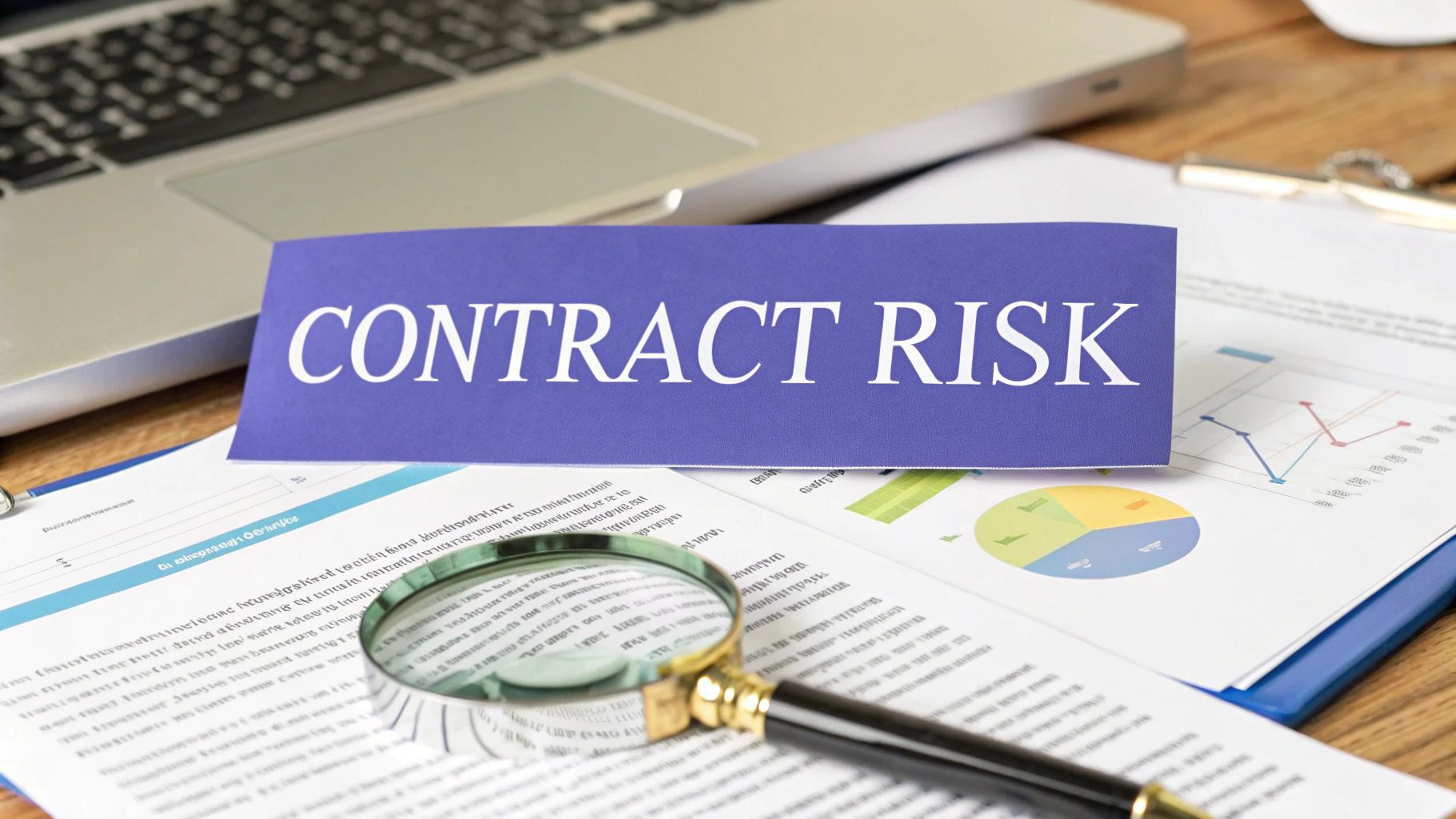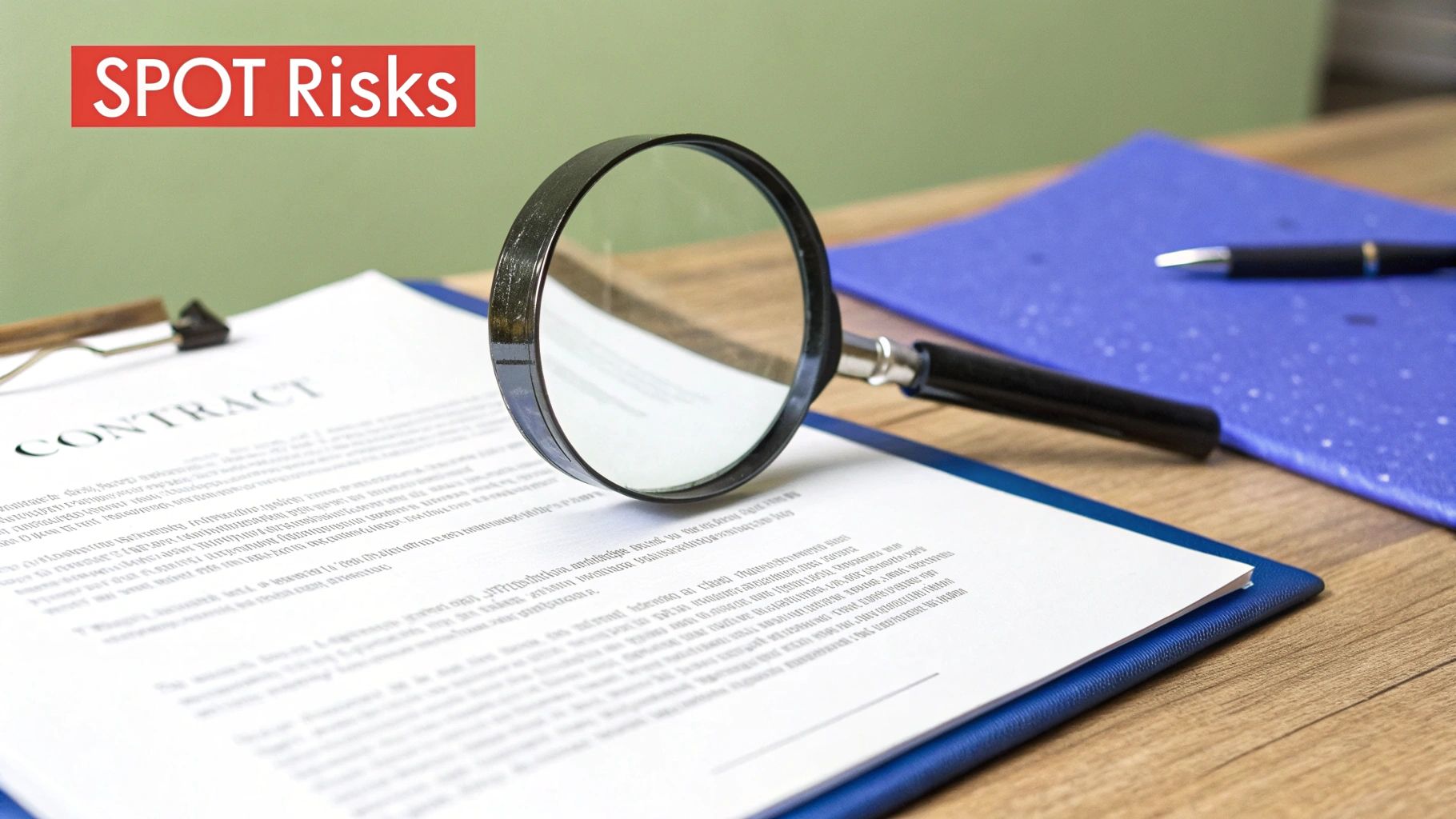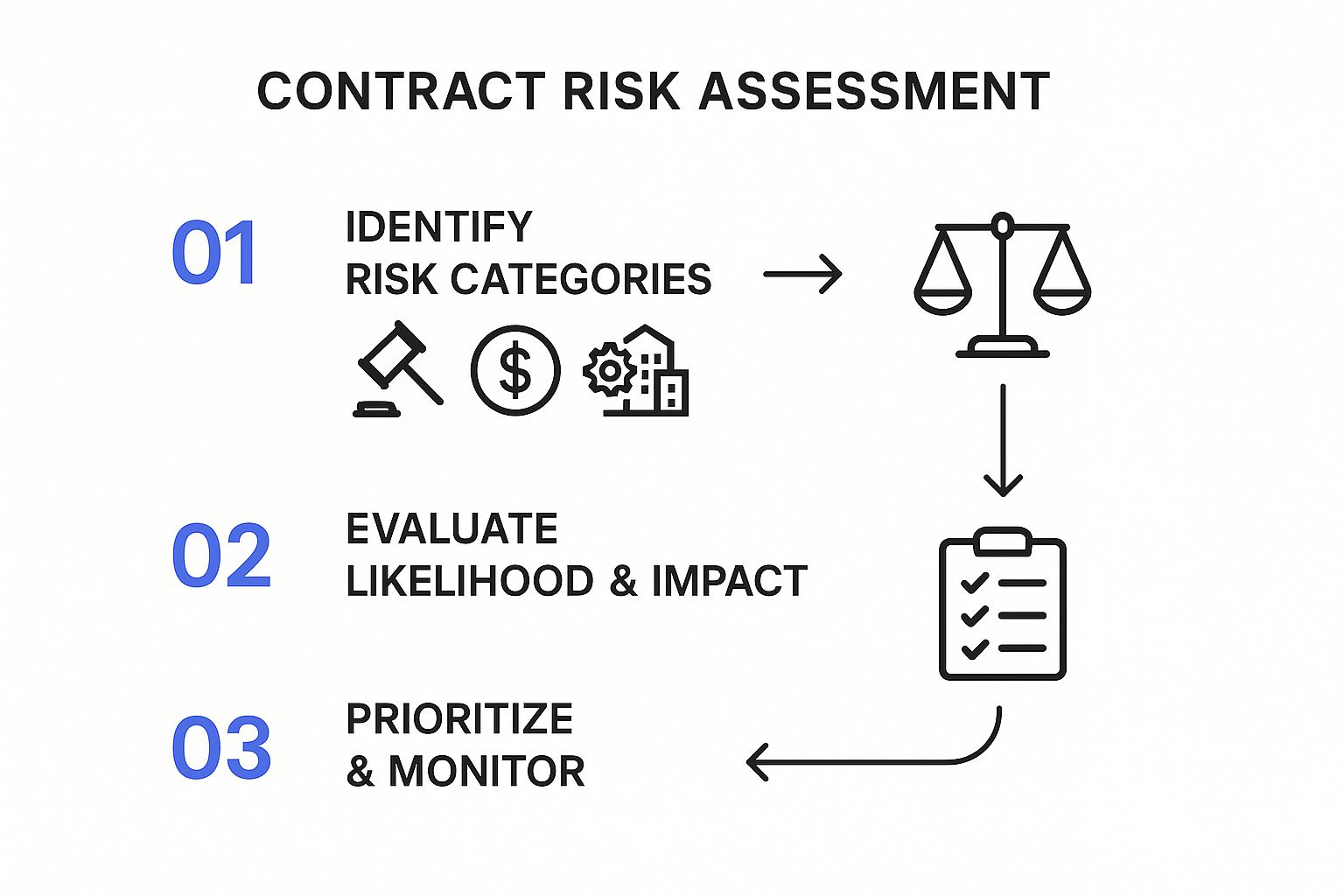
Contract risk management is the process of finding, evaluating, and dealing with potential problems in your business agreements. This isn't just a task for the legal team; it's a core business strategy that protects your revenue, keeps you compliant, and builds stronger relationships by catching issues before they blow up.
Why Proactive Contract Risk Management Matters

Let's be real—most of the time, managing contract risk feels like putting out fires. A problem pops up, and everyone scrambles to find that one clause buried in a 50-page document. This reactive approach is not just stressful; it's expensive, leading to blown deadlines, financial penalties, and a damaged reputation.
But what if you flipped the script? When done right, contract risk management is a powerful strategic advantage. It shifts your focus from damage control to creating opportunities. When you truly understand your contractual landscape, you can build more resilient partnerships, negotiate better terms, and navigate the market with confidence.
The Shift From Reactive to Proactive
Being reactive means you're always playing catch-up. Think of a manufacturing company that signed a supplier agreement without really looking at the force majeure clause. When a supply chain disruption hit, they found out their contract offered zero protection. The result? Production ground to a halt, costing them millions in lost revenue. It’s a classic story, and one that’s completely avoidable.
A proactive approach changes the game entirely. It means systematically analyzing agreements before they're signed and keeping an eye on them throughout their entire lifecycle. This forward-thinking mindset helps businesses:
- Protect Revenue: Prevent the costly disputes, penalties, and operational headaches that drain your profits.
- Enhance Compliance: Make sure all your agreements keep up with ever-changing regulations like GDPR or other industry-specific rules.
- Build Stronger Partnerships: Set clear expectations from the start, fostering trust with your vendors, clients, and partners.
Key Takeaway: The point of contract risk management isn't to eliminate every single risk—that's impossible. It's about making smart, strategic decisions to control it, turning potential liabilities into a predictable and manageable part of your business.
Before we go further, it's helpful to see what these risks actually look like. They can pop up in any part of a contract, from payment terms to data security.
Common Contract Risks and Their Business Impact
Here’s a table that breaks down the most common risks you'll encounter in business contracts and the damage they can do if left unchecked.
| Risk Category | Description | Potential Business Impact |
|---|---|---|
| Financial Risk | Vague payment terms, unclear pricing, or unexpected penalties. | Cash flow problems, budget overruns, and lost revenue. |
| Operational Risk | Unrealistic deadlines, unclear deliverables, or supply chain issues. | Project delays, poor quality work, and business disruptions. |
| Legal & Compliance Risk | Non-compliance with regulations (like GDPR), invalid clauses, or weak liability limits. | Fines, lawsuits, and a damaged company reputation. |
| Security Risk | Inadequate data protection, weak confidentiality clauses, or IP ownership disputes. | Data breaches, theft of intellectual property, and loss of customer trust. |
| Relationship Risk | Poorly defined roles, weak termination clauses, or lack of a dispute resolution process. | Damaged partnerships, difficult exits, and long, costly disputes. |
Understanding these categories helps you know what to look for when you're reviewing an agreement, turning a sea of text into a manageable checklist.
Thriving in a Volatile Climate
In today's shaky economic climate and complex regulatory world, a solid risk management framework is essential for survival, let alone growth. The market reflects this shift; the global risk management market is projected to more than double from US$ 10.5 billion in 2023 to US$ 23.7 billion by 2028. This isn't just a trend—it's a major strategic realignment, with 36% of organizations planning to increase their investment in risk management. You can dive deeper into the risk management statistics shaping the industry.
This proactive stance turns your contracts from dusty legal documents into active business tools. When you know exactly where your risks are—whether in payment terms, data security obligations, or termination clauses—you hold all the cards. You can negotiate from a position of strength, secure better terms, and build the kind of operational resilience that lets your business thrive, even when things get unpredictable. Think of a strong contract risk management process as your company's armor in a chaotic world.
Building Your Framework for Identifying Contract Risks

Finding risks in a dense contract can feel like searching for a needle in a haystack. The language is often complex, clauses are interconnected, and a seemingly small detail buried on page 42 can pose a bigger threat than the obvious terms upfront. So, where do you even start?
The secret is to move beyond just reading the document and start using a system. You need a practical playbook that helps you dissect every agreement from multiple angles—legal, financial, and operational. Your goal is to build a repeatable framework that brings consistency and thoroughness to every review. This process is the very foundation of effective contract risk management.
Starting With a Structured Review
A solid identification framework starts by breaking the contract down into manageable risk categories. Instead of getting overwhelmed by the entire document, you focus your review on specific areas known for hiding significant risk. It’s a targeted approach that makes the process far more efficient and less prone to human error.
Start by creating a simple checklist of key risk hotspots. A basic spreadsheet will do the trick; the important part is being methodical.
Common Risk Hotspots to Investigate:
- Liability and Indemnification: Who is on the hook if something goes wrong? Look for clauses that create uncapped liability or force you to indemnify the other party for things outside your control.
- Termination and Renewal: How can this contract end? Scrutinize clauses that allow termination for convenience (especially by the other party) or include auto-renewal terms that could lock you into a bad deal.
- Data Privacy and Security: How is sensitive information handled? These clauses must align with evolving regulations like GDPR and CCPA. A failure here can lead to massive fines.
- Confidentiality: Are the obligations mutual and reasonable? Make sure the definition of "confidential information" isn't overly broad and that the term of confidentiality is appropriate.
As you work through each category, you’re not just reading; you're actively hunting for specific language that could create future problems. This systematic review is central to a strong contract risk assessment, giving you the data needed for later analysis.
Beyond the Four Corners of the Document
A truly effective framework looks beyond the text itself and considers the world around it. Contracts don't exist in a vacuum; they are subject to market shifts, regulatory changes, and unforeseen global events.
For instance, business interruption remains a top global risk, and it’s often governed by what's inside your agreements. For five years straight, insured losses from natural catastrophes—a key driver of business interruption—have exceeded US$100 billion annually. This, combined with the growing threat of cyber incidents and legislative changes, shows why your contract review must be forward-looking. You can explore the full findings of the Allianz Risk Barometer to learn more about emerging threats.
A contract might have been low-risk when signed five years ago, but new laws or supply chain weaknesses could have turned it into a ticking time bomb. This is why a proactive review framework is essential.
One of the most critical clauses to re-examine in this light is force majeure. A boilerplate clause that seemed fine pre-2020 may be completely inadequate today. Does it specifically cover pandemics, cyberattacks, or supply chain disruptions? Vague language here can leave you exposed when you need protection the most.
Assembling a Cross-Functional Perspective
No single person has a complete view of all potential risks. A lawyer will spot legal liabilities, a finance manager will see cash flow implications, and an operations lead will identify potential delivery failures. Your risk identification framework has to bring these diverse perspectives together.
Actionable Tip: Create a simple risk register—a shared document or spreadsheet—where different team members can log their findings. For each potential risk, capture the following:
- Risk Description: A clear, concise summary of the issue.
- Contract Clause: The specific section and page number where the risk is located.
- Potential Impact: How this risk could affect the business (financially, operationally, or legally).
- Initial Notes: Quick thoughts from the person who flagged it.
This collaborative approach ensures a holistic view. The procurement team might flag a supplier's over-reliance on a single geographic region, a risk the legal team could have missed. The finance team might notice payment terms that could strain cash flow. By bringing these insights together, you build a comprehensive picture of your contractual exposure, turning a solo task into a powerful team effort.
So you’ve got a long list of potential contract risks. Now what? It's easy to look at that list and feel completely overwhelmed. The truth is, not all risks are created equal. Some are just minor bumps in the road, while others could seriously threaten your business.
The real skill in contract risk management is learning to tell the difference and putting your energy where it actually counts.
This isn’t about building some crazy complex financial model. It all starts with a simple way to score each risk. You just need to answer two basic questions: How likely is this to happen? And how bad will it be if it does?
Creating Your Risk Scoring System
A good scoring system is a mix of qualitative and quantitative thinking. You’re basically putting a number on an abstract threat, which makes it much easier to compare one risk to another. The easiest way to start is with a simple matrix.
For likelihood, a 1-to-5 scale works perfectly:
- 1 (Rare): Extremely unlikely to happen.
- 3 (Possible): Could definitely happen under the right (or wrong) circumstances.
- 5 (Almost Certain): It's pretty much guaranteed to happen during the contract's life.
Next, you do the same for impact, evaluating the potential damage on a 1-to-5 scale:
- 1 (Insignificant): A minor hassle with almost no financial or operational fallout.
- 3 (Moderate): This will cause a noticeable disruption or financial hit that needs management to step in.
- 5 (Catastrophic): A business-threatening event. Think major financial loss, serious reputational damage, or even putting the company's future in jeopardy.
Now for the simple math: multiply the likelihood score by the impact score. This gives you a risk priority score between 1 and 25. That single number immediately tells you how high up on your worry list a risk should be. A score of 2 is something to watch, but a score of 25 is an all-hands-on-deck problem.
From Numbers to Actionable Priorities
Once you have a scoring system, you can stop worrying and start acting. This process is all about categorizing risks, understanding how severe they could be, and focusing your response.
This infographic breaks down the basic flow of assessing and prioritizing your contract risks.

As you can see, solid risk management isn’t a one-and-done task. It’s a cycle of identifying, evaluating, and then laser-focusing on what needs to be prioritized and monitored.
Let’s walk through a real-world example. Say you've flagged two risks in a critical software agreement:
- Risk A (Cybersecurity Breach): The vendor’s data security clauses are vague and weak.
- Risk B (Minor Delivery Delay): This vendor is known for pushing back minor feature updates by a week or two.
Time to score them. A data breach (Risk A) might feel unlikely (Likelihood = 2), but the impact would be absolutely catastrophic (Impact = 5). That gives it a priority score of 10.
On the other hand, a small delivery delay (Risk B) is almost certain to happen (Likelihood = 5), but the impact is insignificant (Impact = 1). The resulting score is only 5.
Despite being less likely, the cybersecurity breach is clearly the higher-priority risk. This simple calculation cuts right through the noise, showing you which threat truly matters and stopping you from wasting time on low-impact issues.
Visualizing Risk with a Heat Map
The last piece of the puzzle is bringing this data to life. A risk heat map is just a simple grid that plots all your risks based on their likelihood and impact scores. Think of it like a traffic light: green for the small stuff, yellow for moderate risks, and red for the big, scary threats.
This visual dashboard makes it instantly obvious where your biggest vulnerabilities are. Any risks clustered in that red "high-impact, high-likelihood" corner demand your immediate attention. The ones in the green corner? You can probably live with them or just keep a casual eye on them.
With this approach, contract risk management stops being a guessing game and becomes a data-driven strategy. You’re no longer just putting out fires; you’re proactively identifying your biggest exposures and using your limited resources to protect what matters most.
Developing Your Strategic Risk Control Plan

Analysis is great, but action is what ultimately protects your business. Once you’ve identified and prioritized the risks lurking in your contracts, the real work begins: creating a deliberate plan to control them. This isn't about trying to eliminate every single potential problem—that’s an impossible and impractical goal. It's about making smart, informed decisions to manage your exposure.
A solid contract risk management strategy gives you a full toolkit of responses. At its core, there are four ways to handle any risk you uncover: transfer it, reduce it, avoid it, or accept it. Knowing which lever to pull, and when, is what turns your risk assessment from a theoretical exercise into a powerful defensive tool.
Transferring Risk to Another Party
One of the most effective moves you can make is to shift the risk to someone else's plate. This doesn’t mean ignoring the problem; it means contractually moving the financial responsibility for a specific negative outcome to the party best equipped to handle it. It's a classic and powerful negotiation tactic.
The two main ways to transfer risk are through:
- Indemnification Clauses: Think of this as a promise from one party to cover the other's losses if something specific goes wrong. For example, if you hire a software developer, you’d want an indemnity clause making them responsible for your legal costs if their code infringes on someone else's intellectual property.
- Insurance Requirements: You can—and should—require your vendors, contractors, or partners to carry specific types of insurance at adequate levels. A great example is requiring a construction contractor to have comprehensive liability insurance. If their work causes property damage, their policy covers the claim, not yours.
Key Insight: A successful risk transfer all comes down to clear, unambiguous contract language. A vague indemnity clause or sloppy insurance verification can make this strategy totally useless when you actually need it. Always verify that the other party’s insurance certificates are current and meet your specified requirements.
Reducing the Likelihood or Impact of Risk
When you can't transfer a risk, your next best bet is to shrink it. This is all about taking proactive steps to make the risk less likely to happen in the first place, or less damaging if it does. It’s an area where even small businesses can make a huge impact with internal controls and better processes, often without needing complex negotiations. You can learn more about how this fits into a broader strategy in our guide on small business risk management.
Here are a few practical ways to reduce contract risk:
- Beef Up Your Service Level Agreements (SLAs): Instead of settling for a vague promise of "good service," define specific, measurable performance metrics. Even better, include clear penalties for failing to meet those SLAs, like fee reductions for late deliveries. This gives the other party a strong financial incentive to perform.
- Build a Standardized Clause Library: Create a library of pre-approved, battle-tested clauses for common risk areas like confidentiality, termination, and data security. This ensures consistency across your agreements and stops your team from winging it on high-stakes terms, which is where errors creep in.
- Improve Internal Review Processes: Make a multi-stakeholder review mandatory for all high-value contracts. Getting input from finance, operations, and IT alongside your legal team ensures you’re looking at risks from every angle before you sign.
Avoiding or Accepting Risk Strategically
Sometimes, the smartest move is to not play at all.
Avoiding risk is the most decisive response—it simply means walking away from a deal. If your due diligence uncovers a risk so significant that it can't be reasonably transferred or reduced, declining the contract is the right call. This might happen if a potential partner has a terrible compliance record or flat-out refuses to negotiate on critical liability terms. The potential reward just isn't worth the catastrophic downside.
On the other end of the spectrum is accepting risk. This is a conscious, calculated decision to live with a low-impact, low-likelihood risk. Not every minor issue is worth a drawn-out negotiation. You might, for instance, accept the risk of a minor delay on a non-critical project deliverable because the cost of fighting for stronger penalties outweighs the potential damage.
When you accept a risk, you should acknowledge it and, if necessary, budget for it. Proactive acceptance is far better than being caught by surprise later.
Using Technology for Smarter Contract Monitoring
Let’s be honest: contract risk management isn't a "set it and forget it" task. It’s an ongoing process that demands constant attention. Trying to manually track obligations, deadlines, and performance across dozens—or even hundreds—of agreements is more than just inefficient. It’s a recipe for missed opportunities and costly mistakes.
This is where modern technology completely changes the game, turning a tedious manual chore into a smart, automated function. Think of tools like Contract Lifecycle Management (CLM) systems as your digital watchdog. Instead of juggling spreadsheets and calendar reminders, these platforms pull your entire contract portfolio into one central place, creating a single source of truth for all your rights and responsibilities.
Automating Your First Line of Defense
One of the most practical ways to use this tech is by automating risk detection right from the start. AI-powered tools can instantly scan new agreements and flag non-standard clauses or risky language that deviates from your company’s approved templates.
Imagine you upload a new vendor contract. Within seconds, you get an alert that the liability clause is uncapped or that the data security terms don't meet your internal standards. This isn't futuristic—it's happening now.
This kind of automated review helps you:
- Spot Deviations Instantly: See exactly where a proposed contract differs from your preferred terms without a painful, line-by-line manual comparison.
- Enforce Company Policies: Make sure every agreement sticks to your company's risk tolerance and compliance rules.
- Speed Up Negotiations: Instead of re-reading boilerplate text, you can focus your valuable time on the high-risk clauses that actually matter.
Our own Legal Document Simplifier is built to do just that. It analyzes complex legal documents and pulls out the crucial terms, dates, and financial commitments in plain language. By automating this first pass, you can quickly pinpoint areas that need a closer human look, turning what used to be a multi-hour task into something you can do in minutes.
From Data Points to Strategic Insights
But effective monitoring goes way beyond just flagging a few risky clauses. Real contract risk management means tracking performance against Key Performance Indicators (KPIs) and making sure both sides are holding up their end of the bargain.
A signed contract isn't the finish line; it's the starting gun. Technology helps you monitor the race by turning static contract data into a dynamic, real-time risk dashboard.
Modern tools can automatically track key dates for renewals, expirations, or price adjustments, sending you alerts well in advance so nothing slips through the cracks. This simple feature alone can save thousands by preventing unwanted auto-renewals or giving you the lead time to renegotiate better terms. This capability is a cornerstone of a solid Governance, Risk, and Compliance (GRC) framework.
This screenshot from a recent global risk report shows just how interconnected high-level risks are, demanding a systemic approach.
What this visual drives home is that things like environmental, geopolitical, and technological risks don’t happen in a vacuum. They create a complex web of uncertainty that directly impacts the contracts your business relies on.
By weaving contract risk data into a broader GRC framework, organizations build much greater resilience. As the World Economic Forum's Global Risks Report 2025 points out, these interconnected threats demand a systemic response. A proactive GRC approach allows businesses to embed risk intelligence into their agreements from day one, giving them the agility needed to navigate global uncertainty. You can read more on this GRC perspective and see how it’s shaping business strategy through 2035 and beyond.
This level of foresight gives leadership the visibility needed to make smarter, faster decisions in an increasingly unpredictable world.
Your Contract Risk Questions Answered
Even with a solid game plan, you're bound to run into questions when you start putting contract risk management into practice. This is where the rubber meets the road, and knowing how to navigate common hurdles makes all the difference.
We've pulled together the most common questions we hear from teams getting their hands dirty with this stuff, along with practical answers to help you get it right.
What’s the Single Biggest Mistake Companies Make?
The most common—and expensive—mistake is treating contract management like a filing clerk's job. It’s that old "sign and file" habit, where an agreement gets negotiated, signed, and then disappears into a shared drive, never to be seen again. This completely overlooks the reality that a contract is a living document, full of ongoing obligations, deadlines, and risks that can change over time.
When you operate this way, you're guaranteed to miss critical renewal dates, let vendors slide on their service level agreements (SLAs), and stay blissfully unaware of shifting compliance rules. The contract morphs from a strategic asset into a ticking time bomb of unknown liabilities. Real contract risk management is an active, ongoing process that lasts the entire life of the agreement.
How Much Risk Is Too Much?
There’s no magic number here. A fast-moving startup might happily take on more risk to land a game-changing partner, while a large, publicly-traded company in a regulated industry will be far more cautious. The trick is to define your organization's risk appetite before you're in the hot seat.
A practical approach is to set clear thresholds. For instance, your policy might say any deal with a potential liability over $100,000 needs a sign-off from the CFO. Or maybe any agreement that involves sensitive customer data has to use a pre-approved set of security clauses, no exceptions.
The goal isn't to wrap the business in red tape that kills deals. It's about building smart guardrails that empower your team to move quickly on low-risk agreements while making sure the big, hairy ones get the attention they deserve.
Who Should Be Responsible for This Process?
This is a classic question, and the answer is simple: everyone. Thinking contract risk is just for the legal team is a recipe for disaster. While a lawyer or contract manager might quarterback the effort, they can't see the whole field by themselves.
True ownership has to be spread across departments. A rock-solid program includes:
- Legal: For spotting the obvious legal, regulatory, and compliance landmines.
- Finance: To dig into financial risks like fuzzy payment terms or lopsided pricing.
- Procurement: To check on supplier stability, performance issues, and supply chain weak spots.
- Operations/Project Managers: For flagging operational risks like impossible deadlines or vague deliverables.
The key is building a collaborative workflow where every department has a clear role. If you want to go deeper on this, check out our guide on building a complete contract risk management process from the ground up.
Is This Only for Big Companies?
Not at all. In fact, you could argue this is more critical for small and medium-sized businesses. A single bad contract—a major lawsuit or a key supplier going under—can be a company-killer for an SMB. A massive corporation can often absorb that kind of hit.
You don't need a whole risk department to do this well. The principles scale down. An SMB can start with a simple risk register in a spreadsheet and a basic checklist for reviewing key clauses. The important thing is to be intentional about it, not just reactive. And today's technology gives smaller businesses access to powerful tools without needing an enterprise-level budget.
Can We Really Trust AI with Our Contracts?
This is a great question, and it’s one we hear a lot. It’s smart to be skeptical. The right way to think about AI isn't as a replacement for your legal experts, but as a super-powered assistant that handles the grunt work.
AI is fantastic at the tedious, mind-numbing tasks humans are prone to mess up. Think scanning a 100-page lease for specific dates, flagging clauses that don't match your company's playbook, or pulling every single financial figure into a neat summary.
It does the first pass, freeing up your team to focus their brainpower on what really matters: strategy, negotiation, and high-level analysis. The AI flags the potential issues, but a human is always in the driver's seat making the final call. It’s about making your experts smarter and faster, not replacing them.
We've compiled some of the most pressing questions about contract risk into a clear, easy-to-read table. Below, you'll find straightforward answers to help you navigate the complexities of managing your agreements.
Your Contract Risk Questions Answered
| Question | Answer |
|---|---|
| What's the biggest mistake? | Treating contracts as a "sign and file" administrative task. This ignores ongoing obligations and evolving risks, turning agreements into potential liabilities instead of strategic assets. |
| How do you define risk tolerance? | It varies by company. The key is to establish a formal risk appetite policy before a high-stakes decision is needed. Set clear financial or operational thresholds that trigger higher levels of review. |
| Who is responsible for risk? | It’s a cross-functional team sport. Legal, Finance, Procurement, and Operations must collaborate. Relying solely on the legal team is a common and costly error. |
| Is this just for large enterprises? | No. SMBs have arguably more to lose from a single contract failure. The principles can be scaled down with simple tools like spreadsheets and checklists to make the process intentional. |
| Can we trust AI with contracts? | Yes, when viewed as an assistant, not a replacement. AI excels at tedious, error-prone tasks like flagging non-standard clauses and extracting key dates, freeing up human experts for strategic analysis. |
This table serves as a quick-reference guide, but remember that every organization's needs are unique. The goal is to build a process that fits your specific risk profile and business objectives.
Ready to stop guessing and start seeing what's really inside your agreements? Legal Document Simplifier uses powerful AI to instantly analyze your contracts, leases, and NDAs, pulling out the critical terms, risks, and obligations in plain English. Stop wasting time and get the clarity you need to make smarter, faster decisions. Discover how Legal Document Simplifier can protect your business today.